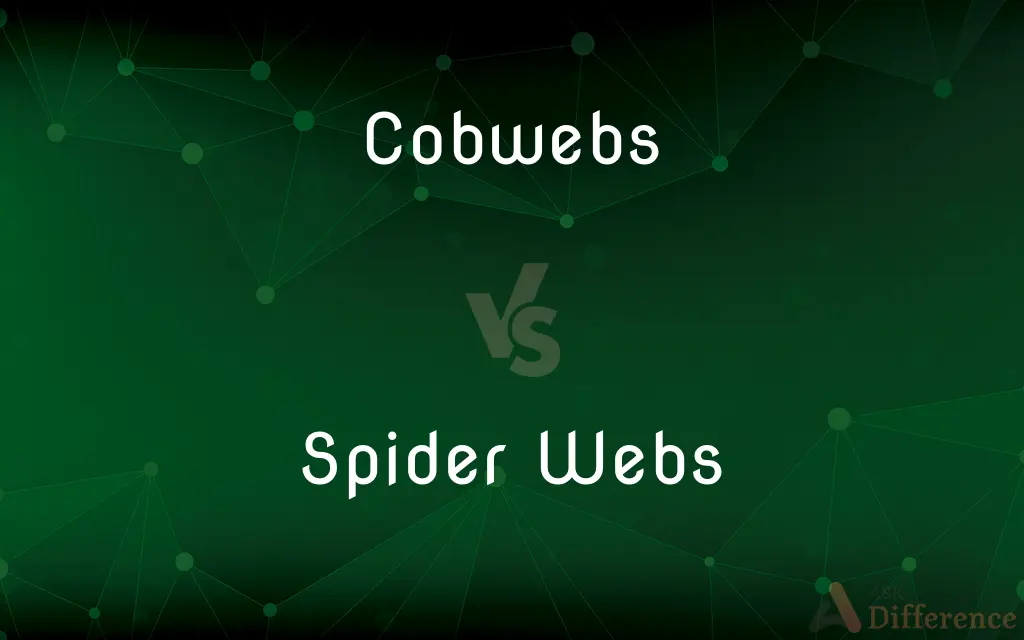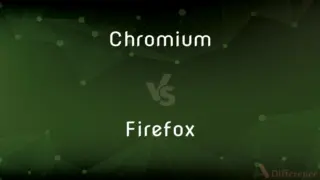Cobwebs vs. Spider Webs — What's the Difference?
Edited by Tayyaba Rehman — By Urooj Arif — Updated on September 9, 2024
Cobwebs are specific types of spider webs, typically abandoned and collecting dust, associated with certain species like cellar spiders, while spider webs are structures spun by spiders for various purposes, including catching prey or housing.

Difference Between Cobwebs and Spider Webs
Table of Contents
ADVERTISEMENT
Key Differences
Cobwebs are a subset of spider webs, often recognized by their irregular, tangled appearance. They are usually the work of spiders from the Theridiidae family, such as the common house spider. Cobwebs are often found in corners of rooms or in areas not frequently disturbed, gathering dust over time, which gives them a characteristic fluffy or dusty look. Spider webs, in contrast, can come in various shapes and sizes, depending on the species of spider and their specific needs. Orb webs, funnel webs, and sheet webs are just a few examples of the diverse architectural styles created by different spiders. These structures are meticulously designed to serve purposes such as trapping prey, providing shelter, or facilitating reproduction.
The term "cobweb" is commonly used to describe any spider web that appears old and filled with dust, but it specifically refers to the webs made by spiders that tend to abandon their webs. Unlike these, many spiders maintain and regularly rebuild their webs to ensure they remain effective for catching prey.
Cobwebs are more likely to be encountered in human dwellings, as the spiders that create them prefer the sheltered environments of homes, where they can find plenty of corners and less-disturbed areas to spin their webs. This preference contrasts with many other spider species that construct their webs in more natural or outdoor settings.
Despite their differences, both cobwebs and spider webs are marvels of natural engineering, showcasing the intricate and purposeful designs of spiders. Whether serving as active hunting grounds or as neglected remnants collecting dust, these structures reflect the fascinating behaviors and ecological roles of spiders.
Comparison Chart
Appearance
Tangled, irregular, often dusty
Varied, including orb, funnel, sheet
ADVERTISEMENT
Creators
Typically house or cellar spiders
Various spider species
Purpose
Often abandoned, collecting dust
Catching prey, shelter, reproduction
Location
Indoors, undisturbed areas
Indoors and outdoors, specific to spider needs
Maintenance
Usually abandoned
Often maintained or rebuilt by the spider
Compare with Definitions
Cobwebs
They're often found in less-frequented areas of homes.
Cobwebs accumulated in the unused basement.
Spider Webs
Spider webs are structures spun by spiders for various functions.
The garden was filled with delicate orb spider webs glistening in the morning dew.
Cobwebs
These webs are less about catching prey and more about past habitation.
The room, filled with cobwebs, looked abandoned.
Spider Webs
Spider webs serve purposes like trapping prey and providing shelter.
The spider waited patiently in its web for the next meal.
Cobwebs
Cobwebs can be easily identified by their messy, tangled appearance.
Cobwebs hung from the ceiling, collecting dust.
Spider Webs
Different species create distinct types of webs.
Sheet webs, spun close to the ground, caught the morning frost beautifully.
Cobwebs
Cobwebs are the dusty, abandoned webs of house spiders.
The attic corners were draped with thick cobwebs.
Spider Webs
Spider webs are often actively maintained.
The spider meticulously repaired its web every morning.
Cobwebs
A spiderweb, especially an old one that is covered in dust.
Spider Webs
They can vary greatly in shape and size.
The funnel-web spider's lair was a marvel of natural engineering.
Cobwebs
Something resembling a spiderweb in gauziness or flimsiness
"An extraordinary number of elegant ladies ... flowed in, heels clicking, diamonds flashing, adjusting tiny cobwebs of priceless lace on immaculate coiffures" (Jane Stevenson).
Spider Webs
Plural of spider-web
Cobwebs
To cover with or as if with cobwebs.
Cobwebs
Plural of cobweb
Cobwebs
Cobwebs are primarily made by spiders from the Theridiidae family.
Cellar spiders often leave behind cobwebs in dark corners.
Common Curiosities
Why do cobwebs collect dust?
Cobwebs collect dust because they are abandoned by the spider and left to accumulate airborne particles over time.
How can you tell a cobweb from a spider web?
Cobwebs are typically dusty, tangled, and abandoned, while spider webs are cleaner, purposefully designed, and often maintained.
How do spiders use their webs?
Spiders use their webs for various purposes, including capturing prey, shelter, mating, and protecting their eggs.
Are all spider webs cobwebs?
No, cobwebs are a specific type of web associated with certain spiders, often abandoned and dusty.
Can cobwebs catch prey?
While they can incidentally trap small insects, cobwebs are not actively maintained for prey capture like other spider webs.
Can cobwebs be used for anything?
Historically, cobwebs have been used for various purposes, including wound dressing, but today they are generally considered a nuisance.
Why do some spiders abandon their webs?
Spiders may abandon their webs if the location is not ideal for catching prey or if they need to move to avoid predators or other threats.
Do cobwebs have any benefits?
In a home, they're mostly considered a nuisance, but in nature, they can serve as indicators of insect activity and environmental health.
Do all spiders spin webs?
No, not all spider species spin webs. Some are hunters that catch prey without webs.
What's the best way to prevent cobwebs in your home?
Regular cleaning and dusting can help prevent cobwebs by disturbing areas where spiders might otherwise settle and spin their webs.
Are cobwebs harmful?
Cobwebs are not harmful, but they can contribute to a cluttered and unclean appearance in your home.
How do spiders create their webs?
Spiders spin webs from silk produced in their silk glands, using their spinnerets to control the silk's release and texture.
Are cobwebs different in various parts of the world?
The spiders that create cobwebs can vary regionally, but the general characteristics of cobwebs are consistent globally.
Do cobwebs indicate a spider infestation?
Not necessarily; while cobwebs indicate spider activity, they often remain long after the spider has moved on.
How do you clean cobwebs effectively?
Cobwebs can be cleaned with a duster, vacuum cleaner attachment, or a cloth attached to a long pole for hard-to-reach areas.
Share Your Discovery

Previous Comparison
Chromium vs. Firefox
Next Comparison
Temperature vs. Thermal EnergyAuthor Spotlight
Written by
Urooj ArifUrooj is a skilled content writer at Ask Difference, known for her exceptional ability to simplify complex topics into engaging and informative content. With a passion for research and a flair for clear, concise writing, she consistently delivers articles that resonate with our diverse audience.
Edited by
Tayyaba RehmanTayyaba Rehman is a distinguished writer, currently serving as a primary contributor to askdifference.com. As a researcher in semantics and etymology, Tayyaba's passion for the complexity of languages and their distinctions has found a perfect home on the platform. Tayyaba delves into the intricacies of language, distinguishing between commonly confused words and phrases, thereby providing clarity for readers worldwide.













































